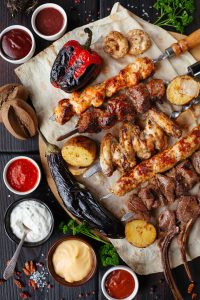 If you’re working out at Prime Fitness in Totowa, New Jersey and want to increase your benefits by adding a healthy diet to the mix, you might have considered the Paleo Diet. Just what is the Paleo diet? Paleo is short for Paleolithic and it consists of the food that is thought people ate during that era. It’s also called the caveman diet. It’s a combination of food that was available to them. This era was before farming, and is thought to be more genetically matched to the body.
If you’re working out at Prime Fitness in Totowa, New Jersey and want to increase your benefits by adding a healthy diet to the mix, you might have considered the Paleo Diet. Just what is the Paleo diet? Paleo is short for Paleolithic and it consists of the food that is thought people ate during that era. It’s also called the caveman diet. It’s a combination of food that was available to them. This era was before farming, and is thought to be more genetically matched to the body.
What can people on the Paleolithic diet eat?
Since it’s before the time of farming, grains, legumes and dairy are eliminated from the diet. During that period, man was a hunter-gatherer. The food available was lean meat, fish, fruit, nuts, vegetables and seeds. There was no refined sugar, vegetable oil or processed food, either, so those are automatically removed from the diet. Aside from the removal of dairy, legumes and grain, it mimics clean eating closely.
There’s little wrong with clean eating, so most of the food choices are excellent.
I’m a proponent of fresh fruit, vegetables and a lean source of protein. There’s nothing wrong with cutting out sugar or adding extra salt. There’s no reason to add unnecessarily add sugar, and the only reason to add salt is if you sweat a lot and need to replace electrolytes. That means, for most people, there’s no reason to add it to food before it’s eaten. Eliminating processed food from the diet is also recommended no matter what healthy diet you follow.
Are there drawbacks to the Paleolithic diet?
If you’re focusing on adding red meat, there’s a potential for consuming a higher amount of fat. That can increase bad—LDL—cholesterol levels. Additional red meat can also increase the risk of bowel cancer. Cutting out the grains can cause a decrease in calories from carbohydrates, since fresh fruits and vegetables are low in calories. That can lead to exhaustion if you’re working out hard. That removal of grains and dairy also decreases the amount of fiber, B-vitamins, calcium, iron, magnesium and selenium.
- Studies show that the weight lost is greater in the first three months of the Paleolithic diet than it is in other diets, but is the same after two years. The difference after two years is that the Paleo diet had better results at decreasing belly fat.
- The Paleolithic diet also has proven superior to other diets when it came to controlling glucose tolerance and blood pressure. It was better for appetite management and lowering triglycerides.
- You don’t have to follow a Paleolithic diet to get the benefits of eating more like a caveman. Simply cutting out processed food and including more fruits and vegetables is a start.
- Cavemen also survived by walking to find their meals. They walked a lot. They only ran when were chased or chasing things. They lifted and carried heavy weights. Consider that part of your diet and include it into your lifestyle. You’ll be healthier for it.
For more information, contact us today at Prime Fitness
